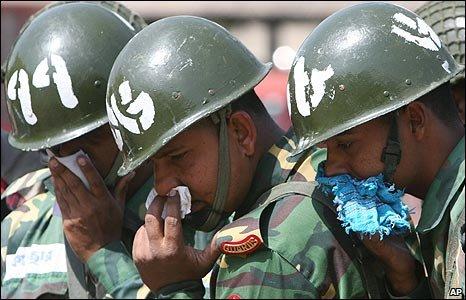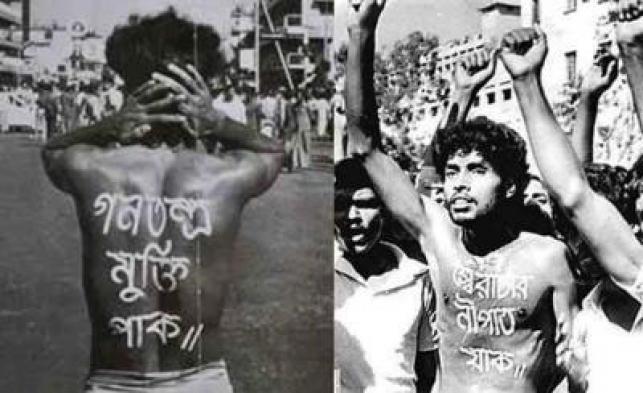25th February 2009
On this day in history:
What appeared initially to be a mutiny from the 25th February – 26th February 2009 by the Bangladesh Rifles (BDR) – a paramilitary force protecting the borders of the country under the command of the army turned into a full blown massacre and slaughter.
The BDR mutineers on the 25th February were demanding better pay, clearance to participate in lucrative United Nations peacekeeping missions and career progression to senior posts which filled from the Army. The act of mutiny in BDR led to the killing of their Commanding General and many others including officers’ families and children came as a rude shock. The Jawans (soldiers) of the BDR also complained about the corruption of Army Officers who come to the BDR for a short tenure and indulged in corrupt practices. However the scale of the mutiny and the brutality of its perpetrators were so vicious than rationally required to press for mere economic demands.
If this was a pay dispute the BDR could easily have resorted to the standard trade union tactic of going missing without leave or refusing to take orders from their superiors. However what happened is really brutal and horrific. The killers had with them a hit list of the Army officers whom they searched out and massacred. They did not stop at that – they mutilated dead bodies of the officers; buried them in mass graves; burnt dead bodies; buried alive some of the officers; and raped, tortured and killed their wives and children. This does suggest strongly that the forces behind the upheaval had their eyes set on a much bigger prize!
Mutiny
The mutiny commenced at 10 am on the 25th February and surprisingly by 12 noon Prime Minister Hasina sent junior ministers Sahara Khatun and Jahangir Kabir Nanak to BDR HQ at Pilkhana as her emissary, they met a delegation of the mutineers led by MD Tawheed for a negotiated settlement of the crisis, at the same time the armed forces were given no orders to move against thr BDR. The mutineer delegation arrived at PM’s residence escorted by Nanak, Sahara Khatun like VIP’s, handed over their hand scribbled demands to Hasina and returned triumphantly with a general amnesty from her.
Throughout the mutiny both junior home ministers Sahara Khatun and Jahangir Kabir Nanak negotiated with the mutineers from the BDR, they in fact moved in out of the BDR headquarters without the need for security. On the second day of the mutiny Sahara Khatun convinced the jawans to give up their arms by assuring them that the Army would not go into the BDR headquarters.
Understanding the Massacre
During the whole revolt the army was ordered to surround the BDR compound but at no time was the compound stormed even though firing was clearly going on. The Awami league government played a dubious role in this incident and gave the rebels ample time to surrender which actually allowed them to carry out all the massacres they wanted and flee the scene without being caught.
There are many questions that need answering?
An analysis of events of the 25-26th February clearly point out the shady role of the Awami League government.
1. Why did the Awami League government not have any information on the conspiracy of this magnitude?
2. Why did the government send inexperienced ministers to negotiate with the rebels?
3. Why did the ministers Jahangir Kabir Nanak and Shahara Khatun go in and out of the BDR compound without need for security? Why did they feel safe and secure in such a hostile environment?
4. Why did PM Hasina give the BDR rebels general amnesty without confirming the fate of the Army officers and their families?
5. Why did the government move the Army 3km away from the BDR camp and black out the whole area? Effectively allowing the criminals to flee from the scene?
India?
There are three points that we need to keep in mind: What did mutiny achieve? Who benefits? As well as the timing.
The answer to the first question can be found in the actual events that took place. – the BDR has been destroyed, its chain of command has been completely ruined. The Army has lost some of its most capable officers and it has been dealt a severe blow. It will take a long time to rebuild the BDR and for the Army to recover.
There is only one external force that benefits from all this – India. The weakening the defence forces of Bangladesh has been a long term Indian plan and she has tried to do this on many occasions in the past. Secondly the BDR protects the Bangladesh border from the Indian border forces (BSF). India has always viewed this as a problem. One former senior Indian intelligence official B Raman wrote a column in the magazine ‘Outlook’ on 27 February, 2009 where he said BDR’s anti- Indian stance is an obstacle to Indian-Bangladesh relationship. The BDR is trained by the Army because of which has resulted in the BDR becoming a very capable force that does the its job very well to the point that the BSF fear BDR. There are many incidents of clashes between the two forces where the BSF simply fled from the fight. Therefore weakening or even destroying the BDR leaves the Bangladesh border unprotected from the Indian BSF aggression. Thirdly as a Muslim country, the armed forces of Bangladesh are always viewed as a security threat by India. The BDR massacre has severely harmed the Bangladesh military.
We should also consider the Indian response during and after the incident. The BSF sent SMS messages during the rebellion to soldiers in the BDR assuring them of assistance. The Indian media launched a frenzied attack on Islamic militants for apparently carrying out the mutiny and the Bangladesh opposition parties also jumped on this to malign the Islamic groups. The Indian Army and air force was kept ready for assisting the Hasina’s government; not in dealing with the mutiny (the Bangladesh Army is capable of doing that) rather to save the government in case of any threats to its existence. And now the Indian government is making statements that the Hasina government has their full backing and they will not sit idly, if there are any threats from events, post mutiny.
The Indian magazine ‘Outlook’ reported that Indian Foreign Minister Pranab Mukharjee said in a closed door meeting of Congress leaders that “… in the current scenario, India is ready to provide any help to Bangladesh …I want to send strong warnings to those who are trying to destabilize Sheikh Hasina’s government that if they continue to do this, India will not remain silent, if necessary, India will directly intervene.” In other words the Indian political leadership is prepared for the fallout of the incident. It seems that India wants Sheikh Hasina to reform and restructure BDR after the 25th February incident. India has attempted in the past to create a Joint Task force which would undermine Bangladesh’s independence.
As for the timing, at present with the Hasina government in power they found a favourable moment to execute their plan. They found internal forces that will assist them in organizing the event and more importantly their future plans regarding the re-structuring of the BDR and the Army.
With the rise of China and India in the region and the interference of the US in the region in recent years Bangladesh has gained strategic importance in terms of regional geo-politics. Right now in the aftermath of the BDR incident all the imperialist powers are undertaking efforts to advance their interests. The US, the British, and the Indians – all are conspiring for control over the Bangladesh Army.
India for long has wanted the Bangladeshi leadership to accept their demands that including a transit route facilities and joint task force as well as Indian gas export.
After the BDR incident Hasina visited the Dhaka Army HQ and meet over 2000 officers. The recording of the meeting is now circulating on the internet. The message that she carried back was that she could no longer trust Bangladesh armed forces neither could she at the same time earn their respect. The Army has setup a parallel investigation to the one setup by the Government further confirming the mistrust between the government and the Army. Under such a situation Hasina invited foreign forces to come in to tame and establish full control over the Bangladesh armed forces, intelligence agencies and all other law enforcing forces under the pretext of restructuring, modernization etc.
Accordingly just after her visit to the Dhaka Army HQ she convened an urgent session of Parliament to discuss the present crisis facing the nation. In her speech she openly sought all out help and assistance from America, Britain, UN and other agencies to come in to restructure and reorganize the untrustworthy armed forces and all other law enforcing forces of Bangladesh including intelligence agencies fighting against terror. However, the fact remains that such a national betrayal is just to secure herself and her Government being dependent on the forces of the foreign masters.
Source: Khilafah.com









